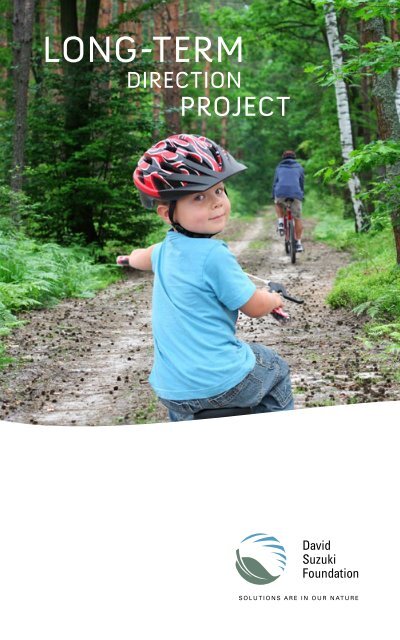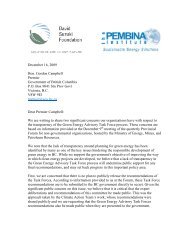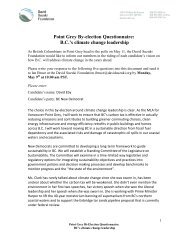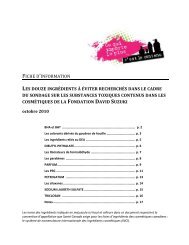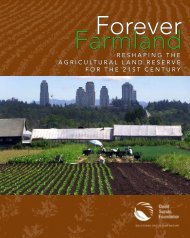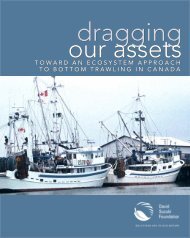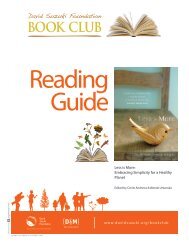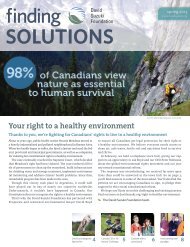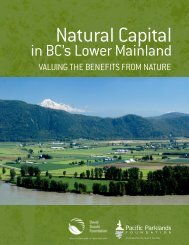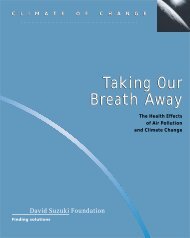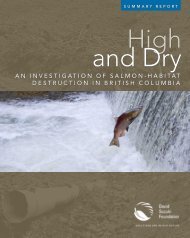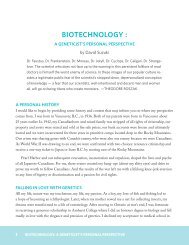Download PDF - David Suzuki Foundation
Download PDF - David Suzuki Foundation
Download PDF - David Suzuki Foundation
Create successful ePaper yourself
Turn your PDF publications into a flip-book with our unique Google optimized e-Paper software.
<strong>David</strong> <strong>Suzuki</strong> <strong>Foundation</strong> Long-Term Direction Project<strong>David</strong> <strong>Suzuki</strong> <strong>Foundation</strong> Long-Term Direction ProjectLONG-TERMDIRECTIONPROJECT
<strong>David</strong> <strong>Suzuki</strong> <strong>Foundation</strong> Long-Term Direction Project
“For me, the rewards of gettinginvolved are that I will be able tolook my children in the eye andsay, ‘I did the best I could.’”— <strong>David</strong> <strong>Suzuki</strong>Overview & purposeIn 2008, the <strong>David</strong> <strong>Suzuki</strong> <strong>Foundation</strong> initiated the Long-TermDirection Project in order to determine the path the <strong>Foundation</strong> willfollow in its third decade and beyond. This document is both a consensusof the project results and the beginnings of a strategic plan,and is based on input from interviews with thought leaders acrossCanada, discussions with board members, and goal-setting exerciseswith staff.The results reflect what we believe to be the role that DSF canplay in a sustainable future for Canada that acknowledges the interconnectednessof people and nature. It is being shared outside the<strong>Foundation</strong> in the hope that it will aid others in their thinkingand work.Our motivation to be clear on our direction and focus is compellingfor a number of reasons. We see increasing and alarming signsfrom all directions that many natural and human systems are beingpushed to “tipping points” beyond which our ability to react andadapt will rapidly decrease. And although polls show that Canadianshave high levels of concern about the natural environment, this hasyet to translate to significant behavioural change or policy shifts.1
<strong>David</strong> <strong>Suzuki</strong> <strong>Foundation</strong> Long-Term Direction ProjectThis document includes a discussion of:◊ Our mission and vision,◊ Long-term outcomes we hope to achieve (by ourselves andwith others),◊ Our principles for social change,◊ Our values and competencies and,◊ Our priority areas of focus and intervention for the next 10years.The outcomes of the Long-Term Direction Project are notintended to be the end of discussion; our exploration and testingwill continue.What we didThe methodology of the LTDP was comprehensive but straightforward.We sought to survey ourselves, our colleagues, oursupporters, the general public, and the latest academic findings onhow best to chart our way forward through the next decade andbeyond. The steps of this process, which happened in a roughlylinear though overlapping manner, are as follows:1. Scoping: We identified the broad project objectives andparameters beginning in January 2008. Some of the questions weexplored included:◊ What is the time frame for our planning; do we need differenttime frames for our trends analysis, goals, and strategies?◊ How can we go about answering the questions we have? Andwho outside the <strong>Foundation</strong> could best help us?◊ What is the process for engaging the staff and board?◊ What will we do with the results?2
<strong>David</strong> <strong>Suzuki</strong> <strong>Foundation</strong> Long-Term Direction Project2. Staff and board engagement: In the winter and spring of2008, we began a series of meetings with DSF staff and board membersto explore future trends, strategy options, and DSF’s positioning.Using that, we started to informally imagine what our work andorganization might be like 10 years from now.3. External engagement: We met with about 50 “thoughtleaders” from a variety of sectors across Canada, including business,academia, the nonprofit sector, the media, and government. We alsotalked to a small number of people inthe U.S. and Europe. This took placefrom March through June 2008.4. Best practices review:We referenced the latest literatureregarding highly effective nonprofitsand social-change models andstrategies, with a particular focus onyouth engagement and communications.5. Sustainability sciencereview: We engaged in a reviewof the latest sustainability scienceto guide our visioning for the nextdecade and beyond.6. Public Opinion Research:The public’s perception of DSF and ofPhoto: doviende / Flickrkey environmental and social-justiceissues was summarized in a numberof recent research studies, including supporter, subscriber and donorresearch, and public opinion research from Angus McAllister, AngusReid, Environics, Harris-Decima, the Frameworks Institute, andJames Hoggan and Associates. In all, we received feedback from morethan 7,000 Canadians.3
<strong>David</strong> <strong>Suzuki</strong> <strong>Foundation</strong> Long-Term Direction Project7. Summarizing themes: Staff and board members worked duringthe summer of 2008 to pull together all the information andinsights described above into a detailed summary document.8. Charting DSF’s high-level direction: The board workedduring a two-day retreat in September 2008 to set the high-leveldirection for staff to work with in developing draft long-term plans.The direction the board provided included the DSF mission andvision, long-term outcomes and strategies, and core DSF competencies.Finally, the LTDP project recommendations were presented toand approved by the DSF board on February 19, 2009.Our proposed strategic directionMission: “To protect the diversity of natureand our quality of life, now and for the future.”Vision: “Within a generation, Canadians act on theunderstanding that we are all interconnected andinterdependent with nature.”DSF’s new vision is first and foremost about people. It assumesthat our mission (diversity of nature and quality of life) will onlybe achieved when people feel inseparable from the natural world.It acknowledges the disproportionate impact that one species— humans — has on the planet.Until now, DSF’s vision was informally captured in our reporttitled ‘Sustainability Within a Generation,’ which was intended toprovide strategic direction for Canada and in particular our federalgovernment. ‘Sustainability Within a Generation’ contained ninecritical societal ‘challenges’ that were in essence policy guides.However, we didn’t develop a compelling narrative to bring the4
<strong>David</strong> <strong>Suzuki</strong> <strong>Foundation</strong> Long-Term Direction Projectidea of ‘sustainability within a generation’ to life for more Canadians(i.e., beyond policy makers). Nor did we articulate what our missionand vision means to our organization in terms of the outcomes insociety and nature we seek, how we do our work, what organizationalgoals we strive for, who we collaborate with, and the kind oforganization we want to become.We wish to see the mission, vision and the idea of ‘sustainabilitywithin a generation’ as inclusive and compelling, not just for policymakers,but for wide segments of the Canadian population. We seekless the hard fought, incremental policy changes and more the socialtransformation that today’s situation demands. While we will continueto do policy and advocacy work, we will also greatly increaseour engagement with people.Our desired outcomes: fast forward to 2020To establish a clearer understanding of the future place we wishto help create, the Board has established three interconnected andinterdependent Long-Term Outcomes. The intent was to clarify thehigh level direction towards our mission and vision, within the contextof a focus on Canada.Our starting focus is the next 10 years. The outcomes willultimately be made tangible and measurable. DSF will explore,describe and act on the interrelationship of these outcomes.OUTCOME #1: NATURE — RESILIENT AND DIVERSE NATURALSYSTEMS. This speaks to the entirety of non-human systems withwhich we are interdependent. The outcome we seek is a futuresituation where these systems (which are also human life-supportsystems) are no longer in decline through processes such as speciesdepletion, loss of forests, accumulations of toxics, climate change,etc. This outcome is about not only ‘natural capital’ but also nonfinancialvalues like the inherent value of ‘wilderness.’ It representsnot only all habitats and ecosystems, but species and genetic diversity.5
<strong>David</strong> <strong>Suzuki</strong> <strong>Foundation</strong> Long-Term Direction ProjectPhoto: istockphoto.comOUTCOME #2: HUMAN SYSTEMS — LIVING WITHIN THE LIMITS OFNATURE. This outcome addresses those human-created systemsthat enhance our quality of life (transportation, energy, food supply,manufacturing, water and wastewater, making cities workable,etc.). As these systems all use nature-based inputs (ecosystemgoods and services) and energy, as well as create waste, we envisionhuman systems that are no longer using materials and creatingwaste in a way that systematically degrades nature (i.e., the largerweb of life upon which we depend).OUTCOME #3: JUSTICE — THE OPPORTUNITY TO MEET BASICHUMAN NEEDS. When human justice is lacking, nature suffers. Thisoutcome means having a society that allows us the opportunityto live a high quality of life and meet our basic human needs. Thisimplies fair and adequate access to resources or environments thatallow healthy living for all (e.g., free of air pollution, toxic pesticides,etc.). The intent is to ensure that the impacts of environmental deg-6
<strong>David</strong> <strong>Suzuki</strong> <strong>Foundation</strong> Long-Term Direction Projectradation are minimized and aren’t disproportionately borne by certainsegments of society. Solutions must also be applied equitably.This outcome also focuses on ideas such as genuine wealth (i.e., notjust financial wealth), human rights and responsibilities, and globalequity considerations.These three outcomes provide a long term direction for our work.The Board purposely kept them at a high level. They are intended toimply an invitation to others who share a desire to see them realized.The invitation is to co-create solutions, and there is incrediblepotential for creative results (renewable energy, toxic-free products,sustainable seafood practices, more liveable neighbourhoods, etc.).Our strategic approach: DSF as a catalyst forsocial change in CanadaDSF has built a strong foundation for its science-based education,advocacy and policy work. Going forward, we will advance ourcommunications and outreach from a one-way platform (DSF topublic, largely opinion leaders in government, business and media)to a more cooperative platform (many to many). We will shift fromrelying on the sheer force of our arguments and research to changebehaviours, to engaging all Canadians in conversations and solutionsabout our shared future. Our new science-based narrative willinform these conversations, but not dictate them.We believe that this approach will both instil a sense of urgencyamong and give hope to Canadians. In turn, this force for good willmeasurably improve the <strong>Foundation</strong>’s existing leverage with decision-makers.We believe The <strong>David</strong> <strong>Suzuki</strong> <strong>Foundation</strong> is uniquely positioned tobe a major catalyst for social change in Canada. We recognize thatjust as important as the vision and outcomes we wish to see arethe ways we help to bring them about — i.e., our principles of socialchange. We have identified three strategic approaches that will7
<strong>David</strong> <strong>Suzuki</strong> <strong>Foundation</strong> Long-Term Direction Projectincreasingly guide our work. In essence — they constitute our modelof social change:1. CO-CREATE A NEW SCIENCE-BASED NARRATIVE ABOUT THEFUTURE. Creating a new narrative will be central to our work inCanada. We know that this means a narrative based on principlesand science — but this narrative is also distinct from traditional,one-way education efforts. It is based on recognizing that peopleoften do not respond through strictly rational motivations; we needto understand how major change really happens. It is a narrativeabout the place of humans in nature, about where we have comefrom and where we are going. It is a positive picture of the future.2. Two-way engagement with the public, government,and the marketplace. The term ‘engagement’ includes solutionstowards our vision, outcomes, and areas of intervention. Becausewe will never have the resources to take on a two-way engagementapproach on a massive scale by ourselves, we will need to becomepart of powerful partnerships with others who share similar goalsand outcomes.3. LEARNING, UNDERSTANDING AND ADVOCACY. Our traditionaladvocacy methods will become part of a more inclusive approachto social change. In some cases, there will remain a strong, clearstance while building more on the solutions-finding we stand for.Learning and understanding will be targeted on individuals andgroups (population segments) depending on context and goals. Ingeneral, there is an opportunity to focus some of our work withschool-age youth.Our values, characteristics and competenciesTo achieve the outcomes and strategies outlined above willrequire specific organizational characteristics and competencies. Weintend to demonstrate the following organizational characteristics:8
<strong>David</strong> <strong>Suzuki</strong> <strong>Foundation</strong> Long-Term Direction Project◊ Embody the essence of <strong>David</strong> <strong>Suzuki</strong>: his vision, abilityto bring meaning and sense to science, and capacity tocommunicate curiosity, passion, respect, trustworthiness.◊ Model the change we want to see.◊ Ground our work in science (natural and social).◊ Stay independent and non-partisan.◊ Keep our primary focus on Canada, and act strategicallylocally and internationally.◊ Take actions that address both short-term and long-termoutcomes.◊ Act in a financially sound manner.We will also demonstrate the following organizational competencies:◊ Act as a catalyst for social change.◊ Work through diverse networks, alliances, and partnerships.◊ Be exceptional communicators, bringing meaning and senseto science.◊ Demonstrate disciplined execution and follow-up.◊ Strategically select projects —use diverse expertise toidentify projects that have the highest likelihood of achievingour outcomes.◊ Develop and advocate for appropriate policy — policy is apath to change, more than it is a means to itself; policy withoutsupport won’t be accepted.◊ Have the capacity to work in the cultures of important keyaudiences — such as new Canadians, youth, first nations, etc.◊ Celebrate, leverage, and meaningfully engage volunteers andmembers.◊ Have the capacity to work in French and English.9
<strong>David</strong> <strong>Suzuki</strong> <strong>Foundation</strong> Long-Term Direction ProjectA critical choice — what will be DSF’s focus overthe next 10 years?Each of the following represents an area of focus, point ofintervention, or combination of issues, where we intend to apply ourthree Strategic Approaches in order to help bring about transformationalchange towards all three Interconnected Outcomes.The following were selected based on our considerable conversationsand research during this project. Some represent newopportunities, or areas we’ll grow into through new competenciesand characteristics, while others remain true to our roots. Each isinterconnected with the others.In line with the global challenges we face, these areas of focusare all deemed ‘urgent’, and DSF will play a major role (except forplaying more of a ‘support’ role with “Reconnecting with Nature”).They are also either on-going, or intended to be phased in over thenext 1 to 3 years, subject to creating the necessary organizationalcapacity.While the exact wording may be refined from time to time, theintent described below for each of following intervention points orareas of focus should be maintained.Reconnecting with Nature. Canadians, with a special focuson youth, are engaged in active, experiential learning that inspiresand reconnects them to their profound interdependence withnature.Protecting Natural Systems. Effective systems are in placeto protect the diversity and resilience of Canada’s marine, freshwaterand terrestrial ecosystems. Natural capital valuation isapplied as a key tool for education and protection.10
<strong>David</strong> <strong>Suzuki</strong> <strong>Foundation</strong> Long-Term Direction ProjectTransforming the Economy. Canada’s vibrant economy stimulatesprogress towards increased well-being, fairness and quality oflife, while increasingly recognizing and responding to the finite limitsof nature. This leads to a more productive, low carbon economy thatdemonstrates efficient resource use, technological innovation andclosed loop processes.Living Neighbourhoods. In communities — the places peoplecall ‘home’ — engaged citizens are empowered to live healthier, morefulfilled and ‘just’ lives. Model ‘living neighbourhoods’ lead the waythrough the transformation of infrastructure, including energy,transportation, water/wastewater and food systems.Protecting Our Climate. Canada is doing its fair share to avoiddangerous climate change and is on track to achieve a safe level ofgreenhouse gas emissions.Photo: istockphoto.com11
<strong>David</strong> <strong>Suzuki</strong> <strong>Foundation</strong> Long-Term Direction ProjectWe see the future as being filled with many challenges and manyopportunities. We hope you will join us in working toward a world inwhich humans can find their place in nature and in which resourcesare shared in an equitable and sustainable way. The next 10 yearswill not be easy, but they will be exciting. By working together,we can make them years of progress rather than crisis.Sincerely,Peter RobinsonCEO, The <strong>David</strong> <strong>Suzuki</strong> <strong>Foundation</strong>604.732.4228www.davidsuzuki.org12
<strong>David</strong> <strong>Suzuki</strong> <strong>Foundation</strong> Long-Term Direction Project13


